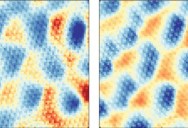Researchers Claim They’ve Proved Quantum Electron Crystals Exist

The exotic material known as the Wigner crystal has existed only in theory for a long time.
Now, scientists say they’ve seen the substance, formed solely from electrons, for the first time.
Along with proving its existence, the images also showed some unusual aspects of the crystal’s nature.
Known substances are composed of protons and electrons, as well as neutrons, because the attraction between them is what gives them stability.
In the 1930s, Eugene Wigner theorized that repulsion can maintain order as well as attraction, and 90 years later, physicists say he was right about the structure of a crystal lattice.
Without protons in the mix, electrons will stay as far away from each other as possible. However, if a way can be found to keep them close, they will arrange themselves at regular intervals.
By trying to maintain as much difference as possible from each other, they will maintain a rigid order – and there’s your crystal.
Physicists proposed this Wigner crystal should exist when the potential energy between electrons is more than 40 times larger than their kinetic energy.

And, since a combination of low temperatures and a suitable magnetic field reduces kinetic energy, their theory is testable.
In the past, physicists created what they thought could be Wigner crystals by trapping electrons in a semiconductor layer just a few atoms thick.
But, they couldn’t prove it, because the reactions were happening on too small of a scale.
Princeton professor Ali Yazdani issued a statement.
“There are literally hundreds of scientific papers that study these effects and claim that the results must be due to the Wigner crystal. But one can’t be sure, because none of these experiments actually see the crystal.”
Yazdani and his team reduced the danger of imperfections by joining carbon atoms in two graphene sheets and scanning tunneling microscope (STM) over the material to confirm their work.
“Our group has been able to make unprecedentedly clean samples that made this work possible. With our microscope we can confirm that the samples are without any atomic imperfection in the graphene atomic lattice or foreign atoms on its surface over regions with hundreds of thousands of atoms.”
They cooled the sheets to basically absolute zero, then placed them in a magnetic field at right angles to the sample. This created an electron gas one electron thick between the sheets.
“In our experiment, we can imagine the system as we tune the number of the electrons per unit area. Just by changing the density, you can initiate this phase transition and find electrons spontaneously form into an ordered crystal.”
What they found is just what they wanted to find: that as electrons get squeezed together their repulsion forces them to make an ordered lattice, which becomes an electron liquid when either the density or temperature is increased further.

With the STM, they could visualize the transition from crystal to liquid.
“Our work provides the first direct images of this crystal. We proved the crystal is really there and we can see it.”
It has a triangular configuration that, due to the repulsion, keeps it stable over a wide range of conditions.
This is a big deal in physics, and has been a long time coming.
You can check out the visualization yourself in Nature; the article is free for the public.
If you thought that was interesting, you might like to read about a quantum computer simulation that has “reversed time” and physics may never be the same.

Sign up to get our BEST stories of the week straight to your inbox.




